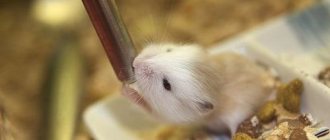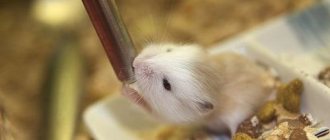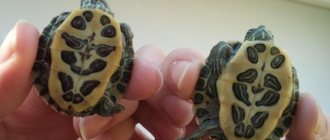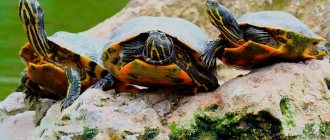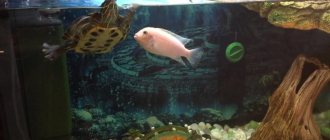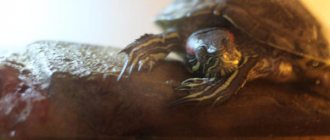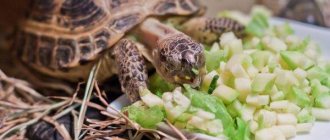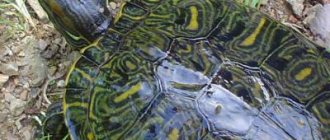Does a land turtle need to be given water?
Many people who have become owners of land turtles and have studied all the intricacies and nuances of caring for these animals doubt whether they need to water their pet and how to do it . Unfortunately, there is not much competent advice on this topic on the Internet, and there is a high risk of harming the turtle by following the recommendations of non-professionals. Therefore, if you are in doubt whether you should give water to a land turtle, carefully study this article.
Price
The cost of an individual varies from 200 rubles to 150,000 or more for rare species. The refusenik can be found on websites for free.
| Name | Price (rubles) |
| Greek, Mediterranean (Testudo graeca) | 2160–4800 |
| Leopard, Panther (Stigmochelys pardalis) | 3840–7680 |
| Indian starfish (Geochelone elegans) | 5000–12000 |
| Redfoot, Charcoal (Chelonoidis carbonaria) | 3840–4800 |
| Madagascar radiata (Astrochelys radiata) | 24000 |
| Central Asian (Agrionemys horsfieldii) | 500–3000 |
Prices depend on characteristics:
- floor;
- age;
- rarity of the species.
How do land turtles drink?
Despite the fact that biologists have been observing the life of land turtles in natural conditions for many years, an exact answer to the question of how these animals drink has not been obtained. Some species of turtles can do without water at all, while others regularly drink from various bodies of water.
The structure of a turtle's head is such that it is quite difficult for it to drink: water simply flows out through the nostrils or flows down the animal's neck. Therefore, most experts believe that turtles receive the necessary moisture from food or through the skin during water procedures. A turtle will drink water from a special drinking bowl only if it has become dehydrated: in this case, the animal tries to replenish the lack of fluid in any way.
Article on the topic: How often should a red-eared turtle be fed at home, how many times a day should a pet eat
Diseases and prevention
Land turtles are in good health and rarely get sick. Diseases can result from improper maintenance or irrational feeding. Common diseases of turtles include: rickets, eye diseases, acute respiratory infections, pneumonia, helminthiasis, intestinal obstruction.
Rickets
The disease is accompanied by a lack of vitamin D3; rickets usually affects turtles that lack ultraviolet radiation. The development of the disease is accompanied by softening and deformation of the shell and plastron.
If rickets is noticed at an early stage of the disease, it can still be managed. To do this, you will need to adjust the power supply and install an ultraviolet lamp.
If the form is advanced, it is advisable to contact a veterinarian for a course of treatment with calcium injections. If rickets stops developing, the deformed shell will remain that way.
It is easier to prevent a disease than to treat it. You should take your pet for a walk in the fresh air so that he can soak up the sun’s rays a little. You also need to review your diet so that it contains enough vitamins and calcium.
Helminthiasis
If your pet is noticed to have frequent stomach upsets, when constipation alternates with diarrhea, and white dots that move are visible in the excrement, then the turtle has become infected with parasites.
Helminths enter the reptile's body with poor-quality food. Parasites can be found in terrarium fillers.
The veterinarian will prescribe the appropriate treatment. For preventive purposes, you can give the anthelmintic Albendazole once every 3 months. Deworming gives a positive result.
acute respiratory infections, pneumonia
If the turtles' mucous membranes become pale, it means the pets have a cold. After some time, breathing becomes difficult, a runny nose appears, everything inside wheezes, drooling with white foam.
Pneumonia rarely occurs in land turtles, but is more common in aquatic species. If you have a cold, your doctor should prescribe therapy with antibacterial drugs. The disease goes away after injections with antibiotics.
Pet turtles are easily susceptible to various diseases
Intestinal obstruction
The problem occurs in those pets who love to eat something inedible, for example, plastic, a piece of gum.
The main symptom of intestinal obstruction is irregular bowel movements. To eliminate the problem, you should try baths (solar and water). If warmth fails to return the turtle to normal life, you need to give an enema with chamomile decoction.
Eye diseases
If your tortoise's eyes become watery and swollen,
If the eyelids close and are difficult to open, then there is not enough vitamin A in the diet. To correct the situation, you need to wash the reptile’s eyes several times a day with a cotton swab dipped in a warm decoction of chamomile.
Your veterinarian may prescribe eye drops: Albucid and vitamin complex injections. It is necessary to reconsider your diet.
Infection with external parasites
Turtles can also get lice or fleas. They become noticeable if you look closely at the turtle's body. If present, you may notice small moving dots.
The treatment is as follows: the reptile’s skin is lubricated with a 5% Karbofos solution. After a few minutes, the applied solution should be washed off with a 0.2% Neguvon solution.
Attention!
Fungal diseases may also appear in the land turtle
.
The fungus appears on the shell.
You can avoid many diseases if you properly care for your pet.
Is it necessary to install a water bowl for a turtle?
When setting up a terrarium, many owners install a special drinking bowl. This is done in order to provide the animal with water. However, there is no need for a drinking bowl: it has already been said above that it is difficult for turtles to drink, since water pours out of their mouths. Often, owners begin to think that this is a symptom of some dangerous disease, and take the turtle to the veterinarian. There is no need to worry: the fact is that turtles (and many other reptiles) do not drink like cats or dogs, but by absorbing moisture while swimming or eating juicy fruits and vegetables. For this reason, the turtle does not need to install a drinking bowl: sometimes the water even irritates the animal and interferes with it.
Reviews from aquarists
Reviews from owners are varied. Someone expresses complete delight, another begins to hate the animal.
How should you feed your turtle?
Owners of land turtles may have a question: how to water their pet so that it does not lack moisture? The answer is quite simple. Reptiles receive the main share of water together with succulent food. Therefore, it is important that the turtle’s diet includes plant foods. For example, fresh cabbage or lettuce leaves can not only saturate a turtle, but also allow it to receive the moisture necessary for normal life. You can give your turtle young dandelion leaves or clover. If you make sure that the turtle always has enough juicy fresh food, the animal will be reliably protected from dehydration.
There is another way to provide moisture to the turtle: you should place it in a tank of water. During water procedures, the animal will absorb a sufficient amount of moisture through the skin.
Compatibility
Turtles are loners. In their natural environment, they gather in groups for mating and fighting. Keep turtles together only if there is no other option and they are of the same species and size. But even then conflicts arise. Different breeds require different conditions of maintenance.
Keep exotic turtles separately.
They can coexist with some iguanas in large vertical terrariums. If you try to make friends with a small reptile, the latter may lose its tail or paws. Turtle secretions are poisonous to snakes.
How to bathe a turtle so that it does not lack moisture?
Bathing a turtle is not done to give the pet the opportunity to get the required volume of liquid, but also for hygienic purposes. It is important to follow some simple rules that will make it possible to achieve both of these goals.
Article on the topic: The oldest turtles in the world: list of long-lived record holders
Here are the basic rules for bathing a land turtle:
- The animal needs to be bathed a couple of times a week. However, you do not need to wash your turtle with soap more than once a week. If your pet's diet contains the required amount of fresh, succulent food, bathing for watering is enough once every two weeks. However, this will not allow you to keep the turtle clean, and two baths a week will allow you to both give the animal something to drink and bathe it;
- Carefully monitor the volume of water and its temperature. Turtles are cold-blooded animals, and their activity level is directly dependent on the ambient temperature. For swimming, you should take water whose temperature reaches 30-35 degrees Celsius. In this case, you don’t need too much water: the liquid level should reach 2/3 of the height of the animal. This will allow the turtle to feel comfortable while swimming and absorb the required amount of water through the skin;
- Do not be alarmed if a turtle defecates during water procedures: this is normal behavior for reptiles. True, in this case it is worth replacing the water immediately, since the pet is unlikely to benefit from staying in the contaminated liquid;
- The turtle should be bathed for approximately 40 minutes.
If you follow these simple rules, your pet will not lack water.
We must not forget that turtles that are sold in pet stores or markets often suffer from dehydration. Therefore, immediately after you bring your turtle home, give it a bath and give it a chance to restore its moisture balance. During the first week of the animal's stay in the house, it is recommended to bathe the turtle daily: this is the only way to normalize the fluid level and maintain the health of your pet.
If you properly care for your land turtle and regularly give it succulent food and water treatments, your pet will delight you for many years: some turtles can live up to the age of thirty or even step over this impressive milestone.
Article on the topic: What do swamp turtles eat, what to feed at home
Reproduction
Age of turtles ready for mating:
- females 10–12 years old;
- males 5–6.
Mating time is from February to August.
Before mating, separate the partners for two weeks. This will increase the male's interest, as will competition in the form of another male.
Maintain the temperature at 25–30 degrees. At lower rates, the male’s sperm will not mature.
The female builds nest holes, usually 2–3, lays up to 6 eggs in each and forgets about the offspring.
Pregnancy lasts 2 months. During and after gestation, the turtle requires increased nutrition.
Place the eggs laid in the hole in the incubator. The soil layer is 18 cm, the temperature is 29–30 degrees. At high temperatures there will be early development of the baby turtle. He does not get out of the shell and dies.
It takes about two months before hatching.
How to determine gender
Sex determination is possible from the age of 1.5-2 years.
Whether an adult is male or female is determined by the following characteristics:
- Body structure. Among the same yearlings, females are clearly larger and more rounded, while the male’s body is more elongated and oval.
- Abdomen. Plastron - the lower part of the shell in females is flat or slightly convex, in males it is concave. This feature is due to the gestation of eggs.
- Spurs. Leather growths on the thighs of males contribute to fixation on the female during the mating process. The female individual does not have them.
- The back of the shell. In males, the tail is curved towards the ground and almost completely covers it. In females the score is almost invisible.
- Tail. Is a sexual organ. In females it is thin and short, in males it is long and large.
- Cloaca. The female one is shaped like an asterisk and is located close to the shell. Male - longitudinal and closer to the tip of the tail.
- Eyes. Most often, yellow eye color is a sign of a female, and brown is a sign of a male.
- Behavior. Females are calm, males are aggressive. Only males participate in fights. Males are also characterized by mating dances and attempts to mount the female.
It is impossible to determine the sex by the claws, since their condition depends on the soil. In nature, males have longer and thicker hair, which simplifies the mating process.
Food in natural habitat
In the wild, land turtles obtain their own food. This is, for the most part, plant food - grass, plant roots, berries, algae from the edges of reservoirs. Some part of the diet of wild turtles is protein food. These are worms, small insects, small snails.
The peculiarity of this reptile is that it can remain without food for quite a long time, storing significant reserves of it in its body during favorable seasons.
These animals are well versed in what vitamins, micro- and macroelements they lack at a certain stage of life and successfully find the products they need in the animal and plant world.
What not to do
- Color the shell.
- Allow it to hibernate.
- Give medications without consulting a specialist.
- Accommodate a new resident without quarantine for a month.
- Allow animals to play with the turtle.
- Keep the turtle on the floor.
- Leave without a shelter house.
- Use fabric, cotton wool, or wool instead of primer.
- Place aggressive pets together.
- Constantly feed the same thing.
- Cat, dog, human food.
- Animal food.
Feeding features of the species
All natural species of turtles are divided according to their feeding method into three large orders:
- predatory;
- herbivores;
- omnivores.
Each of them has their own list of food products necessary for a full-fledged existence. But among the land species of turtles there are no predators, so it is important to consider only the diet of herbivores and omnivores. When purchasing these pets, it is imperative to find out what type of food they belong to.
The omnivorous species that are suitable for keeping at home and most often found in the world are the Mediterranean, musk, flat and Balkan.
Herbivores include star, Indian, Central Asian, Egyptian, serrated, red-headed, radiated, Galapagos.
Omnivores
Their diet must necessarily consist of live food, for example:
- mice and small rats;
- frog;
- snails;
- insects - tubifex, bloodworms, daphnia, beetles, caterpillars, worms;
- slugs;
- fish and seafood.
The plant part of the diet should contain:
- vegetables;
- fruits;
- berries;
- aquatic plants;
- various herbs.
Article on the topic: What to feed a land turtle at home: diet and choice of food for Central Asian and other land turtles
Herbivores
80% of the diet of these land turtles should be products of plant origin - various salads and spinach (leafy part), dandelion, cabbage.
Additional food:
- vegetable crops - pieces of carrots, cucumbers, zucchini, tomatoes, sweet peppers;
- fruits - apples, pears, peaches, apricots, bananas, citrus fruits;
- berries - cherries, raspberries, strawberries, grapes, currants, watermelon;
- other herbs - coltsfoot, sorrel, plantain, alfalfa, legumes;
- mushroom crops, such as champignons;
- special prepared food;
- bran and flakes from plant crops, sunflower seeds.
We recommend reading the article on what to feed pet turtles.
Types of land turtles
The most common in Russia is Central Asian. There are 37 varieties in nature. Distributed in Africa.
Central Asian
In nature they hibernate. Small in size - up to 20 cm. The carapace is rounded, yellow-brown. Diet: 90% plant based.
Mediterranean
The young of this breed do not survive well when kept at home. Choose an adult. It feeds on earthworms, snails, and plant food. Grows up to 28 cm. The carapace scutes form rings with a dark outer edge.
Coal (red-legged)
Requires high humidity and temperatures from 27 degrees. Grows in captivity up to 55 cm. Food: fruits, vegetables, meat.
Leopard print
A body of water is required. A large turtle grows up to 60 cm. The color of the shell is light brown with dark spots. The diet consists of only grass. Juicy vegetables and fruits are dangerous to health.
Radiant
Size up to 40 cm. Very beautiful domed shell. The dark scutes have yellow spots in the shape of stars. The diet contains green parts of plants.
Other types
gear
red-headed flat stellate
ivory
musky
Balkan Egyptian
Purchase and selection
The best-selling breed is the Central Asian. Small in size, does not require special care. Larger turtles are not as easy to keep. They will need a separate large area.
Tips for choosing an animal:
- The phase of greatest activity occurs in the morning and evening. Turtles are also most active in the warm summer months. At this time, it is clear that a healthy pet is offered for sale or a sick one. Note:
- behavior, coordination and activity;
- no damage;
- color without strange spots;
- shell scutes tightly adjacent to each other;
- body shape;
- plaque in the mouth, it should not be there, just like viscous saliva;
- dry nose (discharge indicates illness).
- Try to find professional breeders.
- Choose a juvenile or adult turtle. The baby will require additional care and is susceptible to diseases.
In summer, you can transport the turtle in a cardboard box filled with paper. In winter, place a heating pad in the carrier.
Home Diet Basics
At home, a land turtle does not have the opportunity to independently choose food, obtaining those products that its body needs at a particular moment. In addition, natural instincts are gradually dulled, which is manifested, for example, by the fact that it begins to absorb earth and small stones. Therefore, the owner of the reptile is responsible for the correct and balanced diet of the pet.
In order to prevent imbalances in nutrition, which can cause various diseases, it is recommended to keep a weekly diary of your pet’s nutrition. It creates a daily menu with the correct distribution of doses of vitamin supplements, calcium and amino acids.
The most correct diet would be the following ratio of products:
- herbs, greens - up to 75-80%;
- vegetable and fruit crops, berries - 10-15%;
- cereals, seeds, bread - up to 5%;
- vitamin supplements, micro- and macroelements, animal proteins, amino acids - up to 5%.
As herbs, the greatest preference should be given to the following plant crops:
- dandelion and lettuce (leaves);
- beans, peas, beans (stems and leaves);
- alfalfa;
- plantain;
- clover;
- parsley;
- aloe;
- lawn forbs;
- thistle;
- sorrel;
- sprouted wheat and oat sprouts;
- some flowering plants.
All types of land reptiles love vegetables:
- pumpkin pieces;
- fresh chopped carrots;
- small leaves of young cabbage;
- mature chopped zucchini, squash, cucumbers;
- radishes and beets - only in young fresh form.
Article on the topic: What kind of fish can you feed red-eared turtles
It is advisable to give your pet pieces of apples or pears every day, and occasionally watermelon, strawberries, strawberries, raspberries, currants, peaches, and apricots.
All stone fruits are cored and the products themselves are cut or torn into small pieces.
As a protein component, you can give both worms, insects, snails, and small pieces of boiled or raw meat.
An approximate menu for the day might look like this (in grams):
- sprouted sprouts (for example, wheat) - 50;
- raw young beets, chopped - 30;
- chopped white cabbage leaves - 30;
- chopped boiled potato tubers - 30;
- raw minced beef or chicken or earthworms - 5-10;
- pieces of wheat bread - 25;
- fish oil, vitamins, microelements - 1-3.
It is necessary to give foods containing calcium a couple of times a week. For example, cottage cheese mixtures, cereal porridges - buckwheat, milk semolina or oatmeal.
At least once a week, the diet includes small quantities of seaweed, various bran, sunflower seeds, yeast, soybeans, mushrooms, and ready-made nutritional mixtures.
Do land turtles need water?
These reptiles, like other animals, require water for normal functioning. In nature, they get it from the stems and roots of plants, and also drink it when swimming in ponds.
There is no need to install special drinking bowls for a domestic reptile, but regular bathing should be organized. For some species, weekly water procedures are needed, for others it is enough to carry them out once a month. But it is still optimal to bathe pets once a week, and even more often in the hot season.
It is enough to pour warm water into a small container, not lower than +25 °C, and lower the pet there so that the liquid covers the entire upper shell and reaches at least the middle of the neck.
Article on the topic: What to feed a turtle in winter: the diet of land and red-eared turtles in winter
About little red-eared turtles
Almost all future owners of turtles want to get them when they are still small - cute, touching and funny. But raising such a baby to the average size of a one-year-old is not easy: the mortality rate in babies is very high. And most often - due to improper handling of them.
So what not to do?
- Remove the yolk sac on the plastron from small animals yourself.
- Create stressful situations.
- Take the extra one at a time.
Living conditions need to be made as comfortable as possible. What to feed baby red-eared turtles? Exclusively food of animal origin: 70% small lean fish and 30% by-products, insects, squid, shrimp, etc.
A terrarium for a red-eared turtle of any age should be placed so that it is not exposed to direct sunlight or drafts. But unlike adults, babies need a different temperature regime: water - 26-27 degrees, land - 32 degrees.
Food in summer and winter
Summer feeding of land turtles is usually not difficult, because fresh herbs, vegetables, fruits, and berries can be easily picked or purchased.
Food should be prepared for the winter. Greens can be cut and frozen in the refrigerator, dividing them into daily portions. You can do the same with fruits and vegetables. Forbs can also be prepared in the form of hay.
If there are fish in the house, then you can plant an abundance of aquatic plants in the aquarium and feed your land pet with them in winter.
In the terrarium you can also install clay pots in which alfalfa, oats, wheat stalks, plantain, dandelion sprouts, and cultivated varieties of greens grow. All types of land turtles happily eat sprouted carrot tops.
Mr. Tail explains: foods prohibited for land turtles
The owner of these reptiles should be well aware of the foods that should never be given to pets:
- stone fruit seeds - apricots, peaches;
- citrus peel;
- plants that are poisonous and medicinal, such as buttercup, nightshade, potato and tomato tops, crocus, narcissus, milkweed, delphinium, hydrangea, mistletoe, dieffenbachia, azaleas, lilies, elodea;
- sausages and canned goods.
Porridge, baked goods, dairy products, eggs and eggshells, meat, onions, garlic, celery, spinach stems, radishes, and spicy herbs are allowed only in minimal quantities.
Feeding rules
It is advisable to eat at the same time every day, preferably in the morning.
When feeding turtles, you must follow simple rules:
- Up to a year of age they are fed every day, after two years they can be fed every other day.
- Food utensils should always be washed clean before each feeding.
- Portions should be made small, and excess should be removed from the terrarium so that it does not spoil.
- Try to ensure complete rest for your pet while feeding. The turtle is frightened by loud sounds and sudden movements.
- Reptiles should not be taught to eat from their hands. They very quickly get used to this method of feeding, and then refuse to eat from the bowl.
- You should not overfeed your pets, that is, give food too often, this can lead to obesity and distortion of the carapace and plastron.
- Feeding too infrequently is also unacceptable, as this can cause exhaustion and death.
Article on the topic: How often should a land turtle be fed at home, how many times a day should a pet eat
Taming
To help your turtle eat from your hands, feed it while holding the food with your fingertips. Remember, once your pet gets used to this way of eating, it will begin to chase its owner.
Initially, turtles are not very friendly towards people. To wean your animal from biting, pick it up more often without making sudden movements.
Turtles have excellent hearing; when giving food or before bathing, make the same sound and the pet will begin to respond to it.
Animals remember and recognize their owner. They love to watch what is happening in the room.
Habits are quickly formed regarding feeding times and daylight hours. Not receiving food at the usual time, the pet will sigh and move its head in disappointment.
Does a land turtle need to be given water?
Even those people who carefully study all aspects of turtle care often doubt whether it is necessary to water a land turtle and how to do it correctly. There is no clear answer on the global network, and following unprofessional advice can only harm your pet. If you don’t know how to water a tortoise, our article will help you.
How do turtles drink?
Many years of observation of reptiles in nature have not given a clear answer to the question of how land turtles drink. The fact is that some representatives of reptiles can do without water absolutely calmly, while other individuals try to drink from reservoirs. It is worth noting that the turtle is not adapted to drink, so most often water flows out of the nostrils or flows down the neck. Reptiles get all the moisture they need from food, if it is juicy enough, or through the skin when bathing. This explains the reluctance of some individuals to drink. Only a turtle that is dehydrated and urgently needs some kind of liquid can reach for the drinking bowl.
Is it worth installing a drinking bowl?
Many ignorant people who have adopted a land turtle install a drinking bowl in its home. Of course, they do this only with the best intentions, but the pet does not need the presence of water. As mentioned earlier, when trying to drink, almost all the water pours out through the holes on the reptile’s head. Some land tortoise owners mistake this for a disease and take their pet to the veterinarian. In fact, the reptile is not sick, it is simply not adapted to drink the way we are used to seeing it. Moisture enters the body either from food or through the skin, so the presence of a drinking bowl is not at all necessary. In some cases, water can even disturb the pet and irritate it.
Article on the topic: What do swamp turtles eat, what to feed at home
Wintering and hibernation
Turtles usually spend 8-10 weeks (babies) and 12-14 weeks (adults) in hibernation. If you put it to sleep artificially, you need to calculate the time to wake the turtle from hibernation in February. At this time, the length of daylight hours increases.
The condition of reptiles should be checked every month. It is acceptable if the weight of individuals decreases by 1%. If turtles lose weight quickly, it means they are sick and hibernation must be stopped. You cannot swim during winter.
How to properly put a turtle to sleep:
- You need to make sure that the reptile is healthy. It is not recommended to give vitamins before wintering.
- Immediately before hibernation, it is important to fatten the pet so that it has enough fat reserves for the wintering period. The pet needs to drink.
- The turtle should be bought in warm water, wiped dry and not fed for 1 week (kids), 2-3 weeks (adults). This time is necessary so that all the food eaten by the reptile can be digested.
- Now you need to gradually reduce the temperature and daylight hours.
- For wintering, you need to prepare a special tray, on the bottom of which lay wet sand, peat, and place sphagnum moss. The thickness of the layer should be 20-30 cm. The turtle is placed on this layer and covered with hay or dry leaves. The substrate should be moist, but not wet.
- In this form, the container with holes made in it should spend 2 days at room temperature, then it should be moved to the corridor and placed on the tile.
- You need to know how to wake up a turtle in order to bring it out of hibernation without harming it. All manipulations must be carried out in reverse order. A warm bath will help bring your pet out of his stupor.
If everything is fine with the turtle, it will begin to eat after 5 days, once the optimal temperature has been established.
Preparing for hibernation, the turtle tries to burrow into the ground
